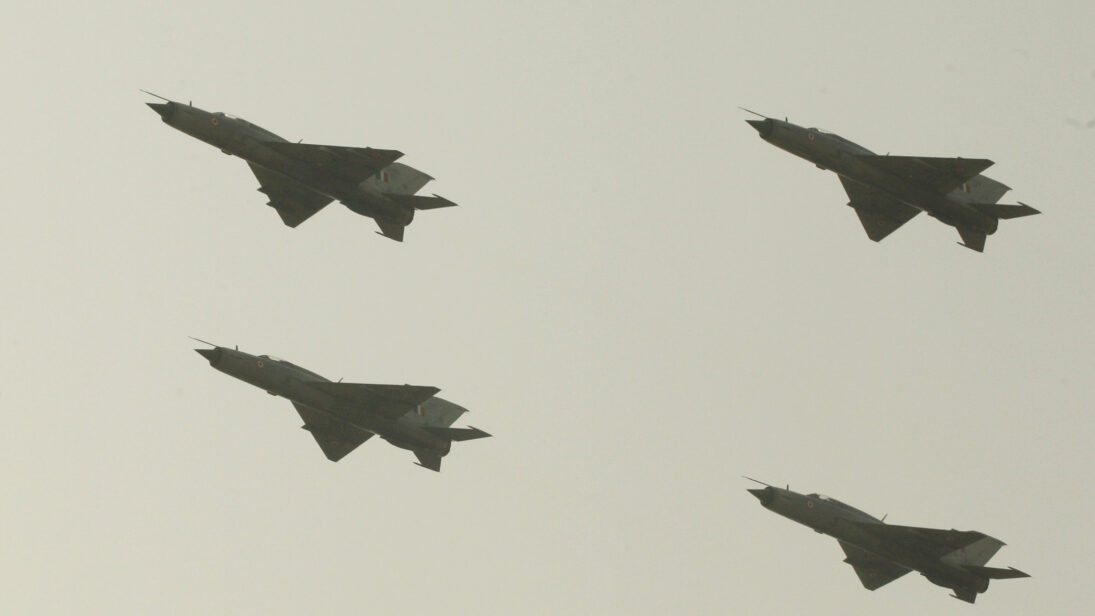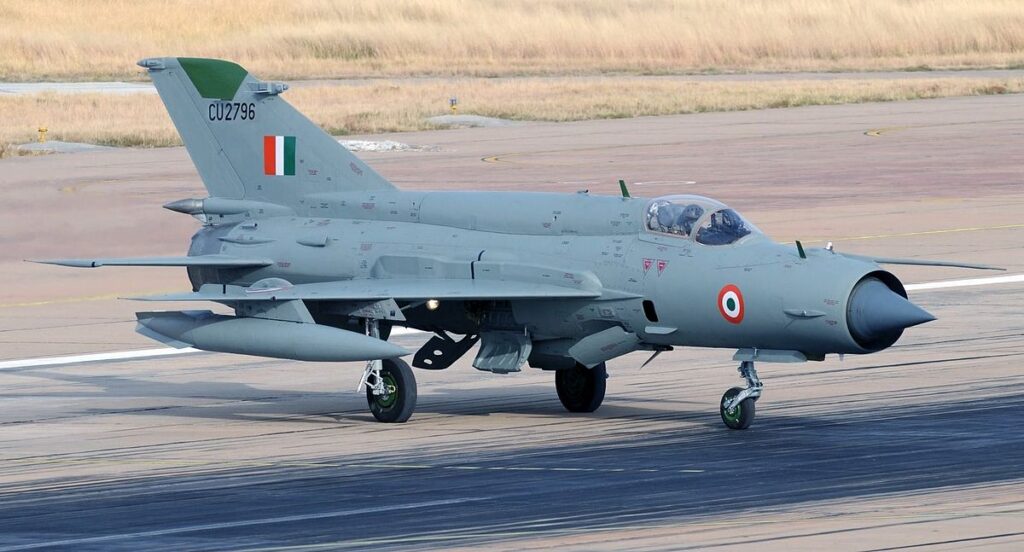
The MiG-21 Fishbed is a single-engine light-weight fighter aircraft developed by the Soviet Union in the early years of the Cold War. It is the most produced supersonic aircraft in aviation history and has been flown by more than 60 nations around the globe. This fighter aircraft has seen extensive combat in West Asia, South Asia and East Asia with varying degrees of success. Despite being an outdated design, several nations still fly upgraded MiG-21 aircrafts and their derivatives. Interestingly, the MiG-21 and its Chinese equivalent called the J-7/F-7 both remain operational in rival air forces of India and Pakistan respectively.
IAF MiG-21 Combat History
First procured in 1963, the MiG-21 was the first ever supersonic aircraft in the Indian Air Force (IAF) fighter inventory. Despite being the longest-serving fighter aircraft in the IAF, MiG-21 has achieved no remarkable feats in air-to-air combat. In the 1965 Indo-Pak war, the IAF was unable to effectively employ MiG-21 aircrafts in combat. Instead, it lost two airframes on the ground during an aerial raid by the Pakistan Air Force (PAF) on the Pathankot Air Base.
In the 1971 war, the IAF deployed eight squadrons of MiG-21 and scored eight air-to-air kills against PAF aircrafts. But the MiG-21 also suffered losses against older generation PAF aircrafts, including the F-6 and the F-86. During the Kargil conflict, the MiG-21 was used primarily for rocketing ground targets. Despite the absence of any aerial threat, the IAF still lost one MiG-21 to Pakistan’s anti-air defenses. One month after conflict termination, the Indian MiG-21 shot down the Pakistan Navy’s unarmed Atlantique aircraft over the Rann of Kutch, reigniting tensions between hostile neighbors. Recently in 2019, the aircraft came into the limelight once again during Operation Swift Retort, when the MiG-21 Bison, flown by W.C. Abhinandan, was shot down by the PAF F-16 fighter aircraft in the Kashmir sector.
To date, more than 400 MiG-21 aircrafts have crashed killing more than 200 pilots, leading it to be aptly dubbed as a “flying coffin” and “widow maker” in the public and in aviation circles.
MiG-21 Problems and Limitations
The Indian MiG-21 is known less for its mediocre-at-best air combat records and more for its high crash rate. To date, more than 400 MiG-21 aircrafts have crashed killing more than 200 pilots, leading it to be aptly dubbed as a “flying coffin” and “widow maker” in the public and in aviation circles. Currently, the IAF operates three combat squadrons armed with upgraded MiG-21 Bison. Despite the gradual reduction in squadron numbers and subsequent decline in flight hours, the aircraft is still highly vulnerable to crashes. The IAF has lost 10 MiG-21 aircrafts in last five years.
The Indian MiG-21 fleet was slated to retire in the late 1990’s upon its end of service life. Instead, the IAF upgraded these aircrafts with new avionics and weapons. These upgrades were not enough to overcome the MiG-21’s inherent deficiencies. The MiG-21 has limited scope for modernization. It has a short range, limited payload capacity, and its small airframe volume also restricts the size of radar antennae that can be housed in the nose cone. Therefore, the aircraft is very limited beyond visual range (BVR) combat capability. At best, the MiG-21 can be used as an interceptor or point air defense fighter with a limited ground strike capability. Due to restrictions in its combat utility in modern warfare, most air forces have either phased out these aircrafts or have withdrawn them from frontline duties. In the IAF, however, these dated aircrafts are still forward deployed and used primarily for interception and air defense duties.
Operation Swift Retort served as a litmus test of the IAF’s combat potential in general, and that of MiG-21 Bison in particular. In the first ever air-to-air engagement since 1971, IAF fighters were overwhelmed by PAF fighter aircrafts’ superior air combat capabilities. One Indian MiG-21 was shot down by a PAF F-16 fighter aircraft. The debris of the downed MiG-21 with all four R-73 and R-77 air to air missiles was recovered.
The pilot, Wing Commander Abhinandan Varthaman was caught and later returned by Pakistan to avoid further escalation with India. In an attempt to escape this embarrassment, IAF orchestrated the story of Abhinandan shooting down a PAF F-16. The story was projected extensively in the media to create a sensation of pride in the Indian public. But it was not substantiated by international observers. After the return of Abhinandan, the IAF chief conducted a sortie to sustain public and air force trust in MiG-21. However, Operation Swift Retort augmented the realization within the IAF that the MiG-21, even after upgrades, is obsolete and has no place in modern air combat.

Challenges with Replacing the MiG-21
Every MiG-21 crash revives the debate over why such a vintage bird is still flying in the IAF. IAF officials have repeatedly covered up the failures of the MiG-21 by projecting its capabilities in the media. In the past, the Indian Air Chief even conducted sorties with the MiG-21 to demonstrate his confidence in the aircraft and regain the trust of its pilots. But by reaffirming its confidence in the MiG-21’s performance, the IAF tries to cover up its failure to replace these obsolete airframes with modern light-weight fighter aircrafts in a timely fashion.
Historically, India has relied on Soviet and Russian origin military hardware to fulfil its defense requirements. India’s domestic defense industry is facing numerous challenges in its quest for full indigenization. These challenges include a lack of technological expertise, inefficient procurement processes, limited private sector participation, resource constraints, and the persistence of import culture in the defense sector. Programs like “Make in India” consequently seek to promote domestic defense production and reduce reliance on foreign sources. While progress is being made, achieving self-sufficiency in defense production remains a complex and long-term goal.
MiG-21’s still fly in IAF colors, not because of their combat potential, but due to delays in the replacement program. The IAF needs at minimum 42 operational combat squadrons to counter the two-front threat, but the IAF currently operates only 32 fighter squadrons. Therefore, the understrength IAF does not have the luxury of retiring its three remaining MiG-21 squadrons. Being a single-engine light-weight aircraft, the MiG-21 cannot be replaced by heavier fighter aircrafts like Su-30MKI or Rafale-F3R. Only a similar category aircraft, like the LCA Tejas, could effectively replace the MiG-21. But delays in the Tejas program have forced the IAF to keep flying MiG-21 aircrafts despite all the risks involved. Currently, only two understrength Tejas Mk1 squadrons with questionable operational status are deployed in the IAF. Once Tejas Mk1/1A production becomes streamlined, only then will the IAF be able to get rid of the remaining fleet of MiG-21 aircrafts.
Every MiG-21 crash revives the debate over why such a vintage bird is still flying in the IAF. IAF officials have repeatedly covered up the failures of the MiG-21 by projecting its capabilities in the media.
Conclusion
The entire story of MiG-21’s in the IAF can be encapsulated in three key points. First, the IAF has failed to timely find a suitable replacement for the MiG-21 aircraft. Long delays in development, production, and induction of Tejas aircrafts have forced the IAF to keep the MiG-21 on active duty. Second, the high crash rate of Indian aircrafts in general and that of the MiG-21 in particular, is a manifestation of the IAF’s poor upkeep and maintenance standards. Finally, the IAF is already deficient in strength compared to its threat perception, so it cannot phase out its obsolete aircraft fleet. Repeated failures in the induction of new aircrafts have shrunk the IAF to the point where it is forced to keep the MiG-21 operational to retain as much squadron strength as possible.
The MiG-21, once the backbone of the IAF, has outlived its utility. For the IAF, it is necessary to redefine its fighter aircraft fleet requirement according to the benchmarks of modern air combat. Moreover, the IAF must materialize its modernization programs as per schedule so that it could counter its depleting squadron strength, avert an obsoleteness crisis, and develop its combat potential to effectively counter the challenges of an emerging threat environment.
Also Read: Understanding the Rafale’s Induction into the IAF
***
Image 1: Rehearsal of four-aircraft box formation with MiG-21 aircrafts via Wikimedia Commons
Image 2: Indian MiG-21 aircraft via Wikimedia Commons


